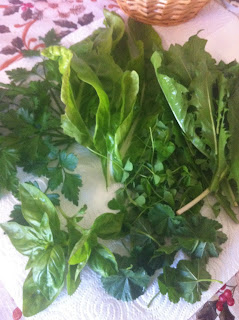FORAGING: THE
NUTRITION IN YOUR GARDEN
So, we all
know that Extra virgin olive oil, small quantities of meat and fish, leafy
greens, legumes, yoghurt and wholegrains and cereals should make up the
majority of what we stuff into our pie-holes now. But what you may not know is that many of the health
benefits attributed to the Mediterranean diet come down to the type of veggies. These centenarian
descendants of the gods wandering around
the shores of the Aegean and the Iberian peninsula in vibrant good health ( it
turns out), eat a lot, a whole lot of
wild greens (Trichopolou et al. 2000, Martins et al. 2011, Dogan, 2012). It
turns out that wild plant foods generally contain much higher concentrations of
essential vitamins and minerals than our commercially grown supermarket fare,
as well as being general powerhouses of antioxidants (Salvatore et al. 2005,
Powell et al. 2014).
The good
news, is that you don’t have to eschew buying textbooks for the next 2 years in
order to fly to Mount Olympus for your wild greens. Many of them will be
springing up merrily in the lawn you should have mowed 2 weeks ago, or hiding
in plain sight about campus.
Here’s 3
little nutritional wonder-bombs that you’ll find pretty easily: Dandelion
greens (Taraxacum officinale), Mallow
leaves (Malva parviflora) and white
clover (trifolium repens). Before you
wrinkle your nose up and tell me you’d rather chomp on some nice bagged kale
from Woolies, let’s have a look at them and then see if we can’t whip up a nice
super-cheap recipe to tempt you…
Now
available for purchase at hipster farmer’s markets, they are rich in Vitamins
A, C, E and K, Folate, Calcium, Iron, Magnesium, Phosphorous, Potassium and
Omega 3 & 6.
You don’t
want the dark green tough and hairy ones, look for bright green, vibrant plants
with similar colour and texture to lettuce. You can steam them, stir-fry them,
or choose young leaves and pop them in a salad. Honestly, the taste is very
much like a romaine lettuce. They get more peppery with age, so choose the
young ones if peppery greens aren’t your thing.
Total weed.
It’s everywhere. But it’s really packed full of pectin, fibre, Vitamins A &
C, calcium, magnesium, iron, selenium, and potassium.
Bigger
leaves can be added to soups (the pectin will thicken the soup) and small
leaves can be roughly chopped and added to salad.
Yes,
clover. Not ‘special’ clover, just the stuff that ruminants and chooks love to
munch on. It’s rich in protein, calcium, chromium, magnesium, phosphorous,
thiamine and vitamin C
Grab really
young leaves and just chuck them in your salad. They’re quite sweet in flavour
but with a definite ‘green’ quality (definition: iceberg lettuce would have a
‘white’ quality on the same scale).
Top left
and moving clock-wise: Flat-leafed parsley, second-growth silverbeet (don’t
take the roots out when the plant seems ‘finished’…it isn’t!), dandelion
greens, white clover, mallow leaves and a bit of remnant basil. Wash and throw
in the salad-spinner, roughly chop and add chick-peas, fetta, red onion,
cucumber, finely sliced granny-smith, chopped walnuts and your favourite
dressing! Wealthy students and CSU staff with y’know, a salary: some strips of semi-dried tomato wouldn’t go astray, and
a few pitted kalamatas would make this the true
Gods-of-the-Mediterranean experience J
I estimate
that this utterly delicious ‘forage salad’ cost me about $2.50 in ingredients
and serves 2. Plus we have a whole world of protein, vitamins, minerals,
healthy fats and antioxidants. I have to admit, the dressing does rather ‘top
it off’, but you can have it as is or add your favourite dressing. Let’s not
get too hung up on the details. It’s food, not a religious experience J
MOUTHGASM SALAD DRESSING
½ cup Extra
Virgin Olive Oil
½ cup Apple
Cider Vinegar (but any form of food-grade acetic acid will do!)
Juice of 1
Lemon
3 garlic
cloves (or 2 tsp dried garlic granules)
1 tsp salt
2 tsp mixed
Italian herbs
½ tsp
ground black pepper
1 ½ tsp
sugar (it’s OK. You’re allowed. It’s not a mortal sin)
Go on, be
brave and try something new!
REFERENCES
Photos by Catherine Lockley (final year B.Hsc
[Food & Nutrition]) CSU
Dogan, Y.
(2012). Traditionally used wild edible greens in the Aegean Region of Turkey. Acta Societatis Botanicorum Poloniae, 81(4)
doi: http://abo.doi.org/10.5586/asbp.2102.037
Garicio-Toro,
M., Gilli, M., Ibarra, O., et al. (2014). Metabolic syndrome improvement in
depression six months after prescribing simple hygenic dietary recommendations.
BMCRes. Notes, 7. P 334
Itsiopolous,
C. (2016). Mediterranean Diet Presentation. Retrieved from daa.asn.au/wp-content/uploads/2016/11/Catherine-Itsiopolous-Mediterranean-Diet-Presentation.pdf
Martínez-González, M.A. et al. (2015). Benefits of
the Mediterranean Diet: Insights from the PREDIMED study. Progress in Cardiovascular Diseases, 58. Pp 50-60
Martins, D.
et al. (2011). Nutritional and in vitro
antioxidant properties of edible wild greens in Iberian Peninsula traditional
diet. Food Chemistry, 125(2). Pp
488-494
Powell, B.,
Ouarghidi, A., Johns, T., Tattou, M.I. (2014). Wild leafy vegetable use and
knowledge across multiple sites in Morocco: a caste study for transmission of
local knowledge? Journal of Ethnobiology
and Ethnomedicine, 10(34).
Salvatore,
S. et al (2005). Antioxidant characteristics of some Sicilian edible wild
greens. Journal of Agricultural and Food
Chemistry, 53(24). 9465-9471
Serra-Majem,
L. (2006). X Anniversary of the Foundation of the Mediterranean Diet
(1996-2006). Public Health Nutrition, 9(8a).
1071-1072
Trichopolou,
A. et al. (2000). Nutritional composition and flavonoid content of edible wild
greens and green pies: a potential rich source of antioxidant nutrients in the
Mediterranean diet. Food Chemistry, 70(3).
319-323





No comments:
Post a Comment